
Common name:Boston Ivy
Botanical name:Parthenocissus tricuspidata
This semi-evergreen vine has dark green leaves that are usually lobed and divided into 3 leaflets. Clings with both tendrils and adhesive-like tips that cements itself to all manner of surfaces. Leaves turn orange or red in autumn. Flowers are inconspicuous. During fall, small blue black berries appear to the delight of birds. This vine can grow 50'-60' long but it really depends on what it is growing on. This vine is aggressive.
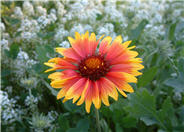
Common name:Blanket Flower
Botanical name:Gaillardia x grandiflora
Blanket flowers are a long-time favorite for hot, dry perennial gardens and meadows. The flowers are daisy-like, with an ombre-like color arrangement from yellow to orange to maroon, though many modern cultivars are single-colored. Eyes range from brown, to maroon, to yellow, depending on the cultivar. Leaves are green to grey green, and either oval to oblong, slightly toothed to deeply lobed. Size varies with cultivars, between 12 to 36 inches tall and 18 to 30 inches wide. Companions well with salvia, agastache, and lavender.
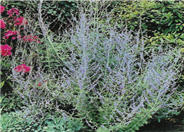
Common name:Blue Spire Russian Sage
Botanical name:Perovskia 'Blue Spire'
'Blue Spire' is a selection of perovskia that grows about 3 to 4 feet tall and 2 to 3 feet wide (though it will grow larger if over-watered). New wood is white and fuzzy; leaves are a soft green to grey-green and finely cut, giving it an airy appearance. Flower spires of fuzzy, lavender blue flowers begin in June and continue through the summer months. Useful in the perennial or shrub border, with ornamental grasses, and as a cut flower.
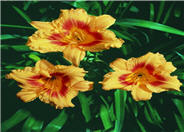
Common name:Black-Eyed Stella Daylily
Botanical name:Hemerocallis 'Black-Eyed Stella'
This selection of the classic Stella d'Oro daylily has golden yellow petals surrounding an intense orange eye. It grows about 2 feet tall, with long strappy grass-like foliage. Trumpet shaped flowers bloom in spring and summer, lasting only 1 day.
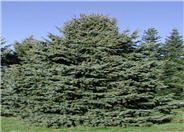
Common name:Colorado Spruce
Botanical name:Picea pungens
Colorado Spruce is an upright to pyramidal evergreen tree with a dense form and horizontal branches. It grows slowly, 60 to 80 feet tall and 20 to 30 feet wide. Its color is variable, ranging from sky blue to green. s to 100' tall. It has a wide-spreading, moderately deep root system if not overwaterred. A Utah native.
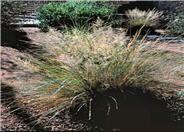
Common name:Bull Grass
Botanical name:Muhlenbergia emersleyi
This Muhlenbergia is a cool season, clumping grass with blue-green, course foliage. It grows about 2 to 3 feet tall and wide. Its plume emerges late summer and is purple, though it turns a silvery white as the season progresses. The whole plant turns tan with the first hard frost. A southwest native, it is very heat and drought tolerant once established.
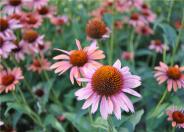
Common name:Purple Coneflower
Botanical name:Echinacea purpurea
The Purple Coneflower is a long-lived, reliable standby for the perennial garden. And while not xeric, it manages quite well with just weekly watering. Rosy purple petals fall below the prominent orange-tinged cone and blooms in late June to September. Foliage is large, with a rounded lance shape. An excellent cut flower, they provide nectar for bumblebees and butterflies, and the seeds provide forage for migrating song birds, so don't cut them all!
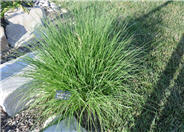
Common name:Fountain Grass
Botanical name:Pennisetum alopecuroides
Fountain grass is a group of warm-season, clumping grasses with graceful forms and early plumes. Foliage is fine-textured and green, with the leaves 1/4 to 1/2 inch wide and up to 30 or so inches long. The form is dense, upright, and mounded, growing from 1 to 3 feet tall and wide, and a little taller while in bloom. Fountain grass tend to bloom before Miscanthus and Panicums, usually by mid-July. Flowers are fox-tail-like and plump, and range in colors from white, cream, pinks, to nearly black. Flowers tend to shatter, but foliage persists into winter.
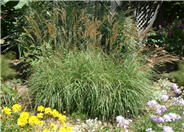
Common name:Japanese Silver Grass, Maiden grass
Botanical name:Miscanthus sinensis
Miscanthus is a large group of ornamental grasses ranging from a few feet to over 7 or 8 feet tall. Blade colors range from solid green, to green with silver mid-ribs, to variegated forms. Plumes are generally held well above foliage clumps, appearing in late summer to early fall, depending on the variety, and may be cut for fresh or dry arrangements.
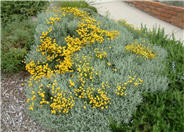
Common name:Gray Santolina
Botanical name:Santolina chamaecyparissus
This perennial has so much going for it, from its lovely silvery grey evergreen foliage to the charming yellow button flowers in summer. Foliage has a pleasing musky, herby scent. Ideal for sunny parkstrips, at the front of the perennial border, near walkways. Grows 18 inches tall and up to 24 to 36 inches wide.
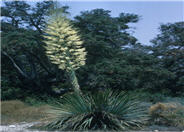
Common name:Adam's Needle
Botanical name:Yucca filamentosa
Adam’s needle (also commonly called Spanish bayonet, yucca, and needle palm) is a virtually stemless broadleaf evergreen shrub (though it looks more like a perennial than a shrub). It features a basal rosette of rigid, sword-shaped, spine-tipped green leaves (to 30†long and to 4†wide) with long curly threads along the margins. Leaves form a clump to 2 to 3 feet tall. In late spring, a flowering stalk rises from the center of each rosette, typically to 5 to 8 feet tall, but infrequently to 12 feet, bearing fragrant, nodding, bell-shaped, creamy white flowers. Fruits are capsules and are edible. Use in rock gardens, as an architectural accent, in a meadow-type planting, or planted among a mass of ornamental grasses. Evergreen.
| Designer: Dr. Condie | Dr. Condie 7 |
Photographer: GardenSoft |
Water Saving Tip:
Even though it's hot, your lawn only needs to be watered twice a week to stay healthy.
And don't water the whole lawn for a brown spot—drag out a hose.
